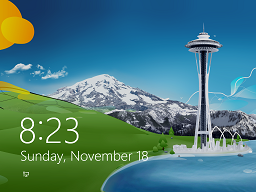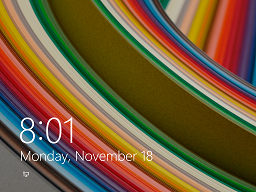Signing Out of Microsoft Windows 8
![]() The articles about logging on and off of Microsoft Windows have been among the most popular in the J.D. Fox Micro Resource Center. While the original articles covered every recent version of Windows, Windows 8 brought enough changes that an entirely new series of articles was necessary. Any reference to Windows 8 in this article applies to both Windows 8 and Windows 8.1.
The articles about logging on and off of Microsoft Windows have been among the most popular in the J.D. Fox Micro Resource Center. While the original articles covered every recent version of Windows, Windows 8 brought enough changes that an entirely new series of articles was necessary. Any reference to Windows 8 in this article applies to both Windows 8 and Windows 8.1.
![]()
![]()
![]() Click here for the edition of this article for Windows 7 and earlier.
Click here for the edition of this article for Windows 7 and earlier.
Introduction
Has your system administrator asked you to log off or sign out of your computer at the end of the day? Are you not sure what that means? This article is for you.
Prior to Windows 8, Microsoft always used the term log off. As of Windows 8, the term is now sign out.
So, what is signing out? Sometimes people think that signing out just means closing all their files and programs. Or, they ask, "Does that mean I must shut my computer down all the way?"
The answer is something in between.
Signing out means saving your files, shutting down all your programs, and then ending your Windows user session and returning to the lock screen. The lock screen is where you see a nice background image, with the time and date prominently displayed.
Here is what the lock screen looks like, on most computers:

Windows 8

Windows 8.1
Windows 8
Windows 8.1
Here are a few reasons you should sign out of your computer:
- Signing out secures your computer and files from people who are not authorized to see them. If you leave your computer signed in when you're away, then anyone can sit down and start messing with, deleting, or copying your e-mail, personal files, or other company data they are not supposed to see.
- It ensures your work is saved and your files are closed properly. If your desktop computer at work unexpectedly shuts off overnight or during the weekend, you might lose data if you didn't sign out.
- The backup system on your network can't copy data files if they're still open. If you don't sign out at night, you might have programs running that have your files held open. If the overnight backup system skips your open files, and then you delete an important file by accident the next day, your data might be irretrievable.
- If you have a laptop that you carry between the office and home, you should sign out whenever you leave home or the office. This will ensure files you access over the local network or VPN are closed and saved properly, so that you don't lose your work or corrupt the file if you turn on your computer at the other location and your computer can't reconnect to the file you had open.
Some people use their computer at work only for one program (like a customer management database), which they keep open all day, and think that when they close the program and only see the Windows desktop icons on their computer screen, they have properly signed out. But, if you can still do anything else besides sign in to Windows (like start programs and open e-mail or websites), then you are not signed out.
No Need to Shut Down
Shutting down means turning off the physical computer unit—all the lights go out and the fans stop blowing. When you turn it back on, everything has to load up again. Generally, you do not need to shut down your computer at the end of the day. If you do, and a network administrator wants to connect to your workstation remotely after-hours to upgrade software, backup your system, or fix problems, he can't. Also, it's easier on computer hardware to run continuously than to be turned on and off every day, and it uses very little electricity.
How to Sign Out
Before you sign out, you should close all your programs and save your files. You can skip this step if you're in a hurry, and Windows will notice if you have any un-saved files open and give you an opportunity to save it. But, it's best if you don't depend on that.
You can sign out with your mouse, your keyboard, or with gestures on a touch screen. Which you use depends on what you have (that is, a conventional desktop computer, a laptop, or a tablet), and what you're comfortable with.
Before reading these instructions, you should be familiar with the new aspects of the Windows 8 user interface, such as the Start screen. If not, click here for an introduction to the user interface changes in Windows 8 (link will open in a new window or tab so you can easily return here).
Sign Out Using Touch 
If you're not at the Start screen, do this:
- If you have a tablet designed for Windows 8, tap the Start button on the chassis.
- On anything else, swipe from the right edge of the screen to get the Charms bar, then tap the Start charm.
At the Start screen, tap your name, then tap Sign out.
Sign Out Using the Mouse 
If you're not at the Start screen, move the mouse all the way into to the bottom-left corner of the screen, and click.
Once you're at the Start screen, click your name, then click Sign out.
Sign Out Using the Keyboard 
With a regular desktop or laptop computer keyboard, on any screen, do this:
![]() Windows 8.1 only
Windows 8.1 only
Press ![]() +X, U, then I
+X, U, then I
![]() Windows 8 or Windows 8.1
Windows 8 or Windows 8.1
Press CtrlAlt+Delete, then Alt+O
Note: If you are logging off of a Remote Desktop session (see below), you must use CtrlAlt+End instead of CtrlAlt+Delete.
More Information
New Terminology for Windows 8
For the entire history of Windows, Microsoft used the term log on and log off for their flagship product, the Microsoft Windows operating system. For Windows 8, the term is now sign in and sign out. The functions and concepts are still the same.
Signing Back In
Before you sign out, make sure you know how to sign in again. You need to know both your user name and password. Some people use their computers for months, never signing out, and don't realize they ever signed in with a password. Then when their computer is rebooted or they have to sign out for some reason, they're stuck! Click here for the article on signing in to a computer running Windows 8.
Switching Accounts
In Windows 8, you may see the Switch account option next to the Sign out option. When you select Switch account, it appears as if you have signed out, because your desktop and all your program windows disappear, and the computer presents the sign in screen so someone else can sign in. But, your Windows sign-in session is still active in the background. In fact, any programs you are running will continue to run (such as a file transfer or heavy computations in progress), and your files will remain open. When you switch away from your account this way, your sign-in session is said to be disconnected.
So, you should only switch users if someone needs to access his account on your computer and it's a really bad time for you to close all your stuff and sign out. To properly sign out of your account once you have switched away and allowed someone else to sign in to your computer, the other user has to sign out, then you must sign back in to your account (using your password) and sign out properly.
Locking Your Workstation
Windows also offers the option for you to lock your workstation. Your computer might even be configured to lock itself if you haven't used it for a while. This also seems the same as signing out, because you have to type your password again to resume work. As with switching to another user, your programs and files all remain open. Locking your computer is good practice for securing your files and e-mail from snoopers or any kind of disruption, if you are nearby and will return to your computer shortly. But, now that you know why it's important to sign out properly at the end of the day, you now know you shouldn't just leave your computer locked when you go home. Unlock it, then sign out properly.
Remote Desktop

Microsoft has offered Remote Desktop capabilities on Windows-based computers for many years. This means you can run a program called Remote Desktop Connection on one computer to log on to another computer across your office network or over the Internet, and access the programs and files on the other computer as if you are sitting right in front of it. If you do this, all the same rules apply. You should properly sign out of your Remote Desktop session using the instructions above. If you merely close the Remote Desktop program window for a remote Windows 8 computer, your sign-in session will continue to run.
Shut Down / Restart

These are the last two options we haven't covered so far in this article, which are generally related to signing off. The Shut down option turns off your computer or device completely, while Restart turns it off, then immediately turns it back on and starts Windows.
To learn more about this, click here for the article on shutting down and restarting Windows 8.
Finally, you might also have noticed options for sleep or hibernate. Click here if you'd like to read about Stand-by, Sleep, and Hibernation in Microsoft Windows.
Read the article about a related topic: Logging on to Windows